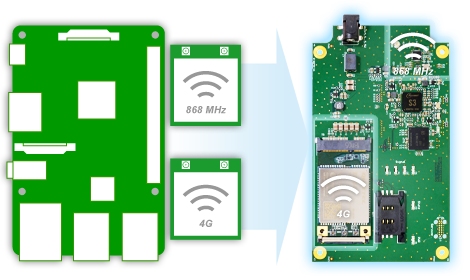Contact · Newsletter · DEUTSCH
Optimizing Radio Interfaces for IoT Applications

The development and marketing of a wireless-based IoT product is still a major challenge. In addition to technical and functional aspects, cybersecurity and numerous regulatory requirements must also be taken into account.
If you are working on your own products and solutions in this area, request our free whitepaper or take advantage of our wireless IoT consultation hour.
We will be happy to help you!
The first product version of an IoT solution in the field of sensor data and cloud connections is often derived directly from the proof of concept prototypes.
A maker board with a suitable housing then frequently forms the link between the local wireless interfaces of the sensors and actuators and a cloud platform on the internet.
In terms of time-to-market, this approach is entirely justifiable. However, the ramp-up to a successful market launch often requires cost optimisation in the bill of materials (BoM), functional enhancements for simple deployment and professional cybersecurity. This is why it sometimes makes sense to redesign important technology components at an early stage.
The white paper "Wireless IoT Retrofit for IoT Radio Applications" shows what needs to be considered in order to turn a prototype into a successful product.
With the eDNP/8331 we offer a concept for virtual System-on-Module (vSoM) solutions including various wireless IoT components. This allows circuits of a 32-bit embedded Linux computer to be integrated together with various wireless interfaces into own application circuits in a cost-optimised manner.
The results are, for example, sophisticated IoT gateway functions for Wireless-2-LAN (W2L) or Wireless-2-Wireless (W2W) applications with integrated cloud connections based on IEEE 802.15.4, 6LoWPAN, 4G or LEO satellite communication.
The complete hardware and software data of the eDNP/8331 is available as a CAD function block and open source software stack.
The CAD data is integrated into the in-house circuit development as part of an Altium PCB design.
Once finished assemblies are available, the software stack can be transferred as a binary image to a microSD card or an eMMC memory module and then booted.
Then we invite you to discuss your specific and individual questions with one of our wireless experts free of charge and without obligation.
You tell us about your problem at your leisure and we will provide you with an initial diagnosis and suggestions on how to proceed!
Every Wednesday 11 AM to 12 PM
(Online meeting via Jitsi or by phone)
Write us a short e-mail and suggest an appointment between 11 AM and 12 PM on a Wednesday.
As an accessory, SSV offers a template for W2L or W2W vulnerability assessments for analysing the final assembly. This uses a vulnerability scanner to generate a list of critical software components plus the corresponding version numbers.
This can then be used to query information on known vulnerabilities in vulnerability databases in order to obtain so-called CVE ID numbers (CVE = Common Vulnerability and Exposure). These CVE IDs can be used to create a risk assessment and prioritisation for own modules in order to initiate appropriate protective measures, such as an AI-based embedded intrusion detection system (IDS).
|
» |
The cybersecurity of the eDNP/8331 is an important milestone to us. In addition to OTA software updates and automatic cyber attack pattern recognition in IoT data streams, we can now also generate a software bill of materials (SBoM) for eDNP/8331 applications. This fulfils one of the main requirements of the EU Cyber Resilience Act.«Jürgen Fitschen // R&D Manager |
SSV SOFTWARE SYSTEMS
Dünenweg 5
30419 Hannover
Phone: +49(0)511 · 40 000-0
Fax: +49(0)511 · 40 000-40
© 2026 SSV SOFTWARE SYSTEMS GmbH // All rights reserved.
ISO 9001:2015